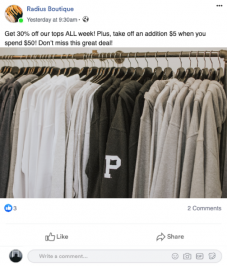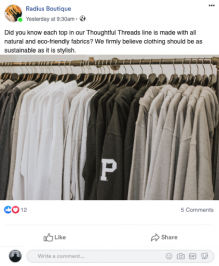How do you decide what to post on your brand’s social media pages? It’s a question digital marketers ask themselves on a daily basis. Unfortunately, many brands take the wrong approach, creating messages from their own corporate perspective rather than what their consumers want.
Brands don’t need to completely reinvent the wheel in order to better connect with their customers. Often, brands have the right idea with the content they put out. With some thoughtful tweaking, companies can take their current social posts and make them much more engaging. Read through our examples below outlining common things brands post on social media and how a value-focused marketer can successfully make them over.
#1. Sharing articles.
One tactic marketers use to beef up their social media presence is to share links of articles relevant to their industry or audience. This can be a really effective and simple way to draw interest to your brand – but not if you just post the article link and title without any additional explanation, question or opinion. An article posted on its own usually gets lost in the shuffle because there’s no compelling reason to engage with it.
Instead, take the very same article you were about to share and add your own take in your post. You may know exactly why you’re sharing the article, but keep in mind your customers don’t always have as much industry knowledge as you. Adding just a sentence or two gives the user context, which provides a reason for them to follow the link. You might give your opinion on the issue, add a funny takeaway or share another perspective. Another thing your brand could try is asking a question or encouraging readers to share their thoughts on the story. When they read the article and find it was actually valuable to them, they will be more inspired to comment and further interact with the post.
#2. Doubling down on sales-y posts.
Why bother using social media unless it’s to generate sales, right? Not necessarily. When marketers constantly publish posts hounding customers to make a purchase, the brand comes off as pushy and aggressive rather than genuinely helpful. You know who customers don’t want to buy from? Brands that are pushy, aggressive and not helpful. In fact, according to cloud service company NewVoiceMedia, 51% of customers said that after one negative experience, they would never do business with that company again.
Social media doesn’t work when you only use it to make direct sales. It’s more effective when you instead use it to form lasting connections with users and actively work to make your audience feel heard and cared about. You can still talk about the products and services your company offers but try coming at it from a value-driven mindset. We recommend offering helpful tips related to your industry and mentioning just one of your products or services as an option. Giving your customers valuable advice will demonstrate how your brand works to help its customers and they’ll be more motivated to give you a like or ask a question in the comments.
#3. Sharing a post without an image or video.
When you come up with a clever sentence or piece of information you think would be interesting to your audience, you might be tempted to quickly post it to your page and get it out there. But if you’re missing an image or video to go with it, your wonderful thought will likely get lost in the crowd.
Simply adding a related photo or video to the post can give you a big boost in engagement. Images and videos tend to earn significantly more impressions and interactions, because they’re attention-grabbing and help create emotions in customers. In fact, according to Hubspot, tweets with images receive 150% more retweets than tweets without images. Plus, all it takes is a quick scroll of Facebook to realize nearly every post has some kind of image attached. If you don’t have a relevant company photo or a video readily available, there are a number of free resources you can use to find images that won’t appear too staged or cheesy.
#4. Constant promotion of deals and discounts.
Everyone loves a good deal, whether it be a free appetizer or 20% off sitewide. But what happens when discounts are the only thing you’re promoting on your profile? The nonstop deals become white noise and can ruin the sense of urgency if customers know they won’t wait long for the next great deal. Plus, you position your company as the “discount brand,” and that’s not what anyone wants to be known for.
When you’re considering posting about the new deal of the day, think first if there’s another way to give your audience value without focusing on price. If you offer one of your products at a lower price every Thursday, you might talk about an interesting fact or little-known benefit of the product. When customers know that a company understands and appreciates them, they’re more willing to make purchases – even at full prices. According to a study from PwC, 42% of consumers said they would pay more for brands that offer a friendly, welcoming experience.
#5. Deceptive Paid Ads
You know when you see a social media post or website article on your homepage with the word “sponsored” or “promoted” beneath the username or headline? These paid ads that fit into the natural look and feel of a site are called native advertising, and they can be one of the most effective methods to earn more engagement online. Be careful, though. Some native ads can cross over into deceptive advertising if it’s not clear the message has been paid for. Plus, if your content is purely self-promotional and not value-driven, you risk making your audience feel tricked into consuming your content.
If you’re going to publish a piece of native advertising, first make sure the platform you choose will clearly designate it as a sponsored post from your brand. Then consider how you will make the content worth it for audiences to read – even if they think it’s organic content at first. You can give advice on common problem, tell an interesting story or comment on a timely event related to your industry. When possible, opt for subtle persuasion over in-your-face product promotion. When they realize you’ve paid for the placement, it’ll be easier for users to digest upfront value than a huge sign-up form blocking them from the content they want.















0 Comments